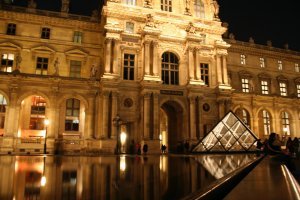Advertisement
Published: March 25th 2009

 Louvre by Night
Louvre by Night
Not actually in Carcassonne...but fun all the same :)Last weekend I spent one night down in the town of Carcassonne in southern France located between Toulouse and the Mediterranean Sea. I bought my train ticket on Friday and on Saturday took the TGV fast train to Bordeaux and then a smaller train though through the countryside to Carcassonne. The train rides were absolutely beautiful. We passed by green rolling hills, vineyards, and through small towns. In Carcassonne, there is a beautiful river that runs through the city and people sit on the banks and picnic and read. Kari showed me our hotel, a cute little bed and breakfast with a balcony view of the Castle of Carcassonne. The castle is the main attraction here and so we wasted no time and headed the hill. This castle is complete with moat and draw bridge, not like the silly other French chateau's that were just for looks 😊
The old city of Carcasssone was built by the Romans and was occupied by the Visigoths in the fifth century. Carcassone was ruled by the Trencaval family, early in the thirteenth century, the city was conquered by northern French forces.
The famous walls of the Old City contain survivals from all these periods.
The walled town of Carcassone is roughly rectangular in shape, up to 525 meters long and 250 m wide. It is surrounded by its medieval double enclosure wall; the inner curtain is 1245 m in length, with 29 towers, while the outer has 18 towers and is 1320 m long.
The inner wall, started by the Visigoths and Roman foundation and added to by King Louis IX of France and his successors, has twenty nine rounded towers. Within the inner wall is the caste built by the Trecavels in the twelfth century. The outer wall, which was built by Louis IX in the 1240s contains seventeen towers. Most of the outer towers were built with open sides facing the inner walls so that if taken the towers could not provide protection for the attackers.
In the 12th century the building was described as a palace but it was transformed into a genuine fortress when the earliest enclosure wall was consolidated and the second rampart built. Three curtain walls were built to the south, east and north of the palace, proceeded by a moat and flanked by six round towers with the same characteristics as those of the outer wall, battered
bases, superimposed, rib-vaulted chambers and stirrup-shaped loop holes. The defenses were directed against the city to resist uprisings against the new royal administration.
The inside of the walls reminded me of Mont Saint Michel with all the cafe's and shops. It was late afternoon when we arrived, so we knew that we would have to come back the next day to see more of the castle. We wanted to head back to the hotel so that we could watch the sunset from the balcony. We bought wine and strawberries and had a romantic sunset viewing!
We woke up early and got fresh squeezed orange juice at a cafe inside the castle situated around a beautiful courtyard and spent the rest of the morning walking along the walls of the castles. From the castle, we had a view of vineyards, cemeteries, and the whole city of Carcassonne. When left the castle to gather picnic goods and spent the rest of the afternoon lounging by the river and reading. It was a quick trip, but so good to see Kari and a pretty incredible little castle 😊
Advertisement
Tot: 0.054s; Tpl: 0.011s; cc: 8; qc: 24; dbt: 0.0348s; 1; m:domysql w:travelblog (10.17.0.13); sld: 1;
; mem: 1.1mb

 Louvre by Night
Louvre by Night